Two years have passed since R.M., a Syrian scientist, fled her country with her family. She left by plane, without telling anyone. She had been waiting for her chance – about three years before that, a former apartment of hers had already been destroyed by an air attack. And now, if she were to return, she’d likely be punished with imprisonment.
R.M. was relocated to Canada with the help of Scholars at Risk and to stay anonymous, she asked to go only by her initials. She recalls that her university department in Syria had 16 faculty members. But now, she says, six to eight of them have left due to the Syrian civil war, leaving the faculty at half its original size. And she is just one of thousands of displaced researchers affected by conflicts in troubled parts of the world.
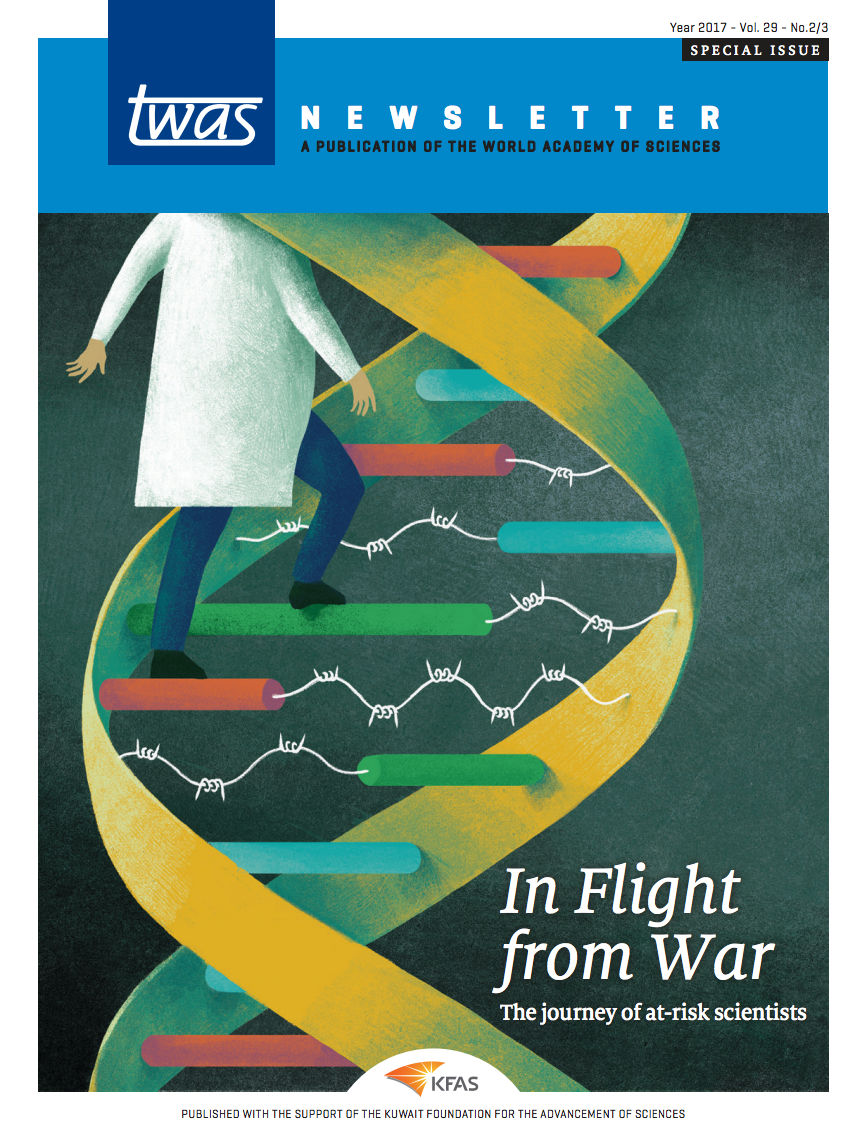 “It was impossible to continue living there,” R.M. said. “Our home was nearly aflame like an oil refinery. There was a big fire. So I left and I had nothing but a laptop, my kids and a few clothes.”
“It was impossible to continue living there,” R.M. said. “Our home was nearly aflame like an oil refinery. There was a big fire. So I left and I had nothing but a laptop, my kids and a few clothes.”
Though it is rarely noted in news accounts of the mass migration caused by recent wars, scientists, engineers and others in science-related fields are among those fleeing for their lives. These researchers find themselves in new countries, in need of support for their careers and aid integrating with their host countries. And it falls to policymakers and the scientific community to chart a path forward.
But to do so, they must be able to address a core question: Just how many displaced scientists are there?
The answer? Nobody knows.
And that has important implications for policy and for science, both in the nations adjacent to the countries in conflict and to the nations of Europe and North America.
James King, assistant director of the U.S.-based Institute of International Education’s Scholar Rescue Fund (IIE-SRF), says that being able to more clearly illustrate the magnitude of the crisis would allow IIE-SRF and other organizations to seek more funding and additional university hosts. The organisation has argued that it’s important for U.N. agencies that track refugees to de-aggregate universityage people from refugee counts and categorize asylum-seekers by professional and educational background.
But still, no effort to identify displaced scientists in this way exists. The best that organizations like IIE-SRF can do is piece together an estimate distilled from broad refugee counts, nations’ pre-war data on higher education, applications for assistance, and stories like R.M.’s.
“It’s very imperfect,” said King, “but it at least gives you a sense of the scale. It’s not hundreds, it’s thousands – and that alone I think is useful.”
But considering the impact of recent wars and conflicts in Syria, Iraq, Yemen and Afghanistan, and counting a cohort that includes scientists, engineers, medical professionals and advanced students in these fields, the number probably exceeds 10,000.
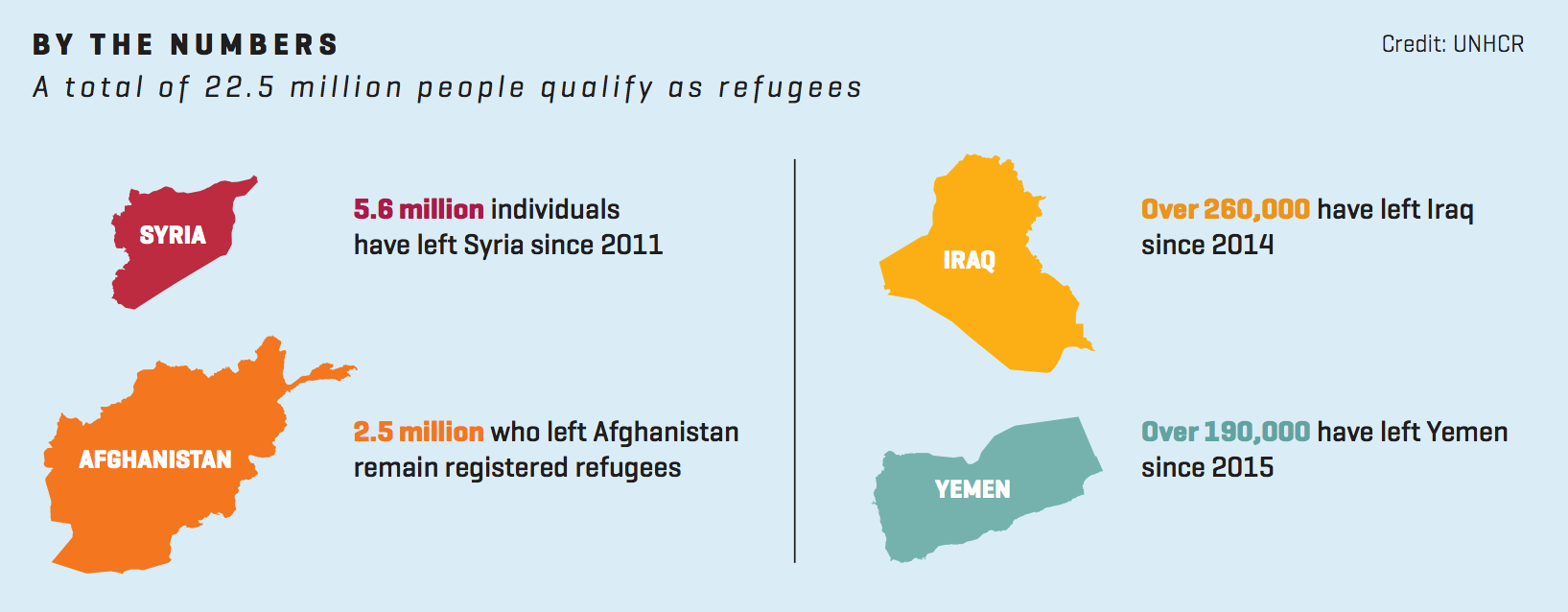
The numbers at hand
As of the end of 2016, the United Nations High Commissioner for Refugees (UNHCR) tallied 65.6 million displaced people in the world, including 22.5 million who qualify as refugees, and 10 million who are considered stateless. An estimated 5.6 million have left Syria since 2011; over 260,000 have left Iraq since 2014, many driven away by the conflicts with Islamic State. Over 190,000 have left Yemen. In addition, millions of people are displaced within those countries as well.
The greatest number of those who have fled are now in neighbouring countries, UNCHR reports. For example, there are at least a million in Lebanon and 740,000 in Jordan. The UNHCR estimates that over 5.1 million refugees were in Europe by the end of 2016, whatever their profession - about 2.9 million in Turkey, and 2.3 million in the remaining European states.
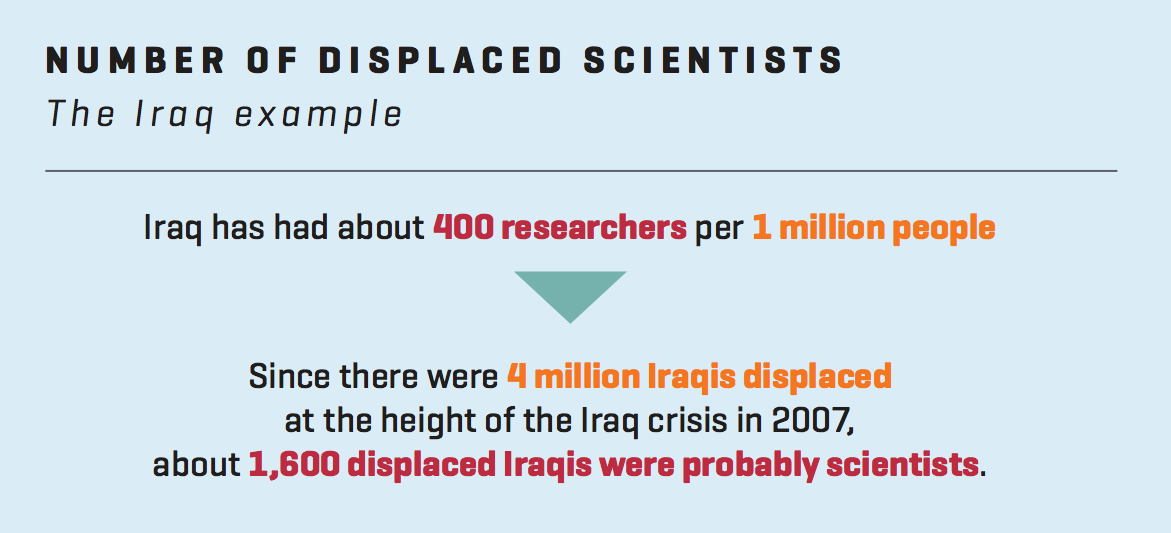 But there is no count of how many among them are in the science-related fields. So without a full census, or a science-based projection, how can we estimate the number?
But there is no count of how many among them are in the science-related fields. So without a full census, or a science-based projection, how can we estimate the number?
The 2015 UNESCO Science Report details how many citizens in countries are scientists. For example, the UNESCO report says that Iraq, before the latest conflict, had about 400 researchers per 1 million people. At the peak of the Iraq War crisis in 2007, some 4 million Iraqis were displaced, so a rough projection might be that 1,600 of them were scientists.
The numbers of scientists are not available for pre-crisis Syria, Yemen or Afghanistan. Still, the rough projection from Iraq seems to suggest that the number of scientists among those displaced from those four countries combined has a floor in the thousands.
But additional signals and clues can be sifted from news accounts and other data.
According to a 2016 report in Foreign Policy, Syria had roughly 31,000 doctors before the conflict – and the report cited an estimate from Physicians for Human Rights that half have left the country. According to the German Medical Association, among 430,000 Syrian refugees recently taken in by Germany, some 1,500 are working doctors.
Students are also a significant part of the refugee population. A 2016 report by Chemistry World found that Germany welcomed 271 Syrian masters and PhD students that year, under a programme administered by the German Academic Exchange Service (DAAD). They received over 5,000 applications – about five times what DAAD anticipated.
A dramatic rise in applications
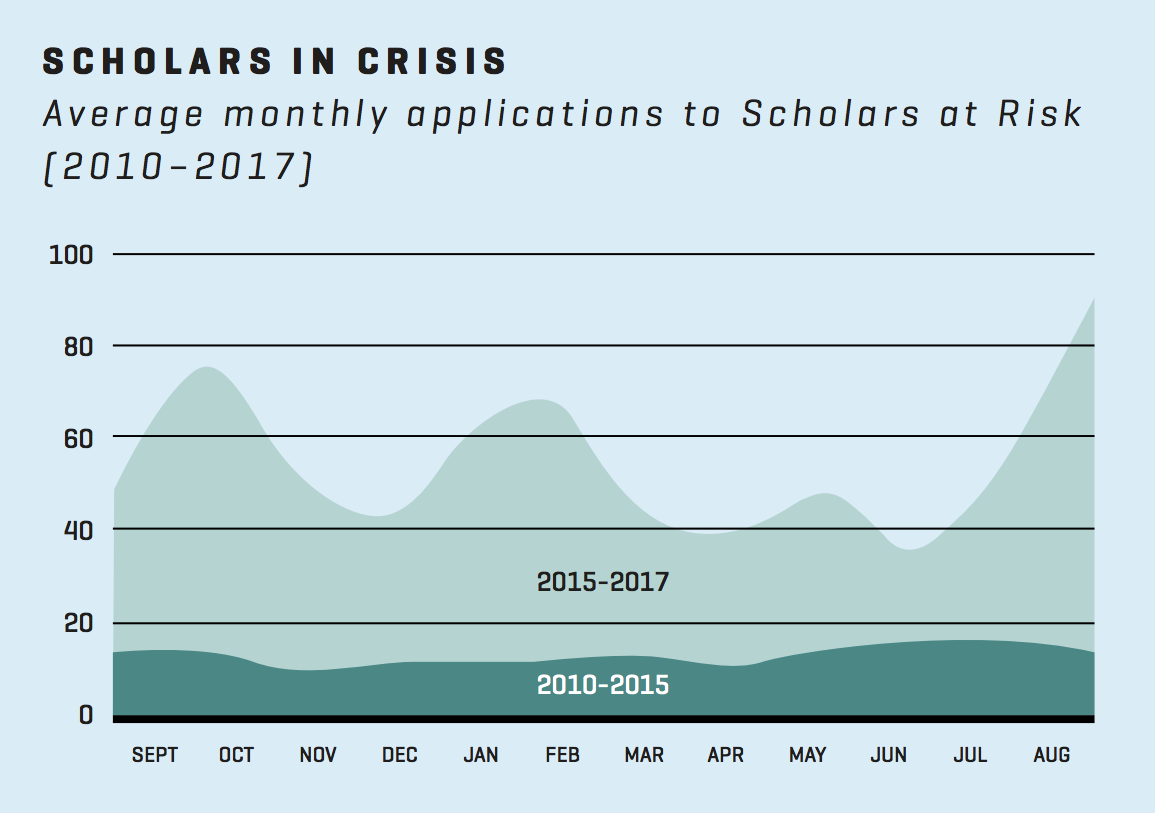 Important to understanding the volume of displaced scientists are three organizations that lead the way in finding new homes for academics fleeing peril. They provide the most clear indications of how many displaced scientists there are in the world: IIE-SRF, which arranges and co-funds fellowships for threatened scholars to continue their work in safety at partnering academic institutions worldwide; CARA, The Council for At-Risk Academics, aBritish non-governmental organization that provides two- or three-year stays in various countries for displaced academics; and Scholars at Risk, an international network of institutions and individuals which arranges for temporary academic positions at member universities and colleges.
Important to understanding the volume of displaced scientists are three organizations that lead the way in finding new homes for academics fleeing peril. They provide the most clear indications of how many displaced scientists there are in the world: IIE-SRF, which arranges and co-funds fellowships for threatened scholars to continue their work in safety at partnering academic institutions worldwide; CARA, The Council for At-Risk Academics, aBritish non-governmental organization that provides two- or three-year stays in various countries for displaced academics; and Scholars at Risk, an international network of institutions and individuals which arranges for temporary academic positions at member universities and colleges.
Numbers collected by the major scholarrescue organisations can also deepen understanding of the scientists among the broader migration from conflict zones.
In recent years, they report, application numbers have been climbing. “That’s a reflection of the situations in many countries around the world where higher education has been decimated by war or targeted repression,” said King.
IIE-SRF saw a 50% increase in applications from 2015 to 2017, driven by the Syrian crisis and also the aftermath of the 2016 coup attempt in Turkey. In 2017, SRF supported 200 scholars from 25 countries.
Allan E. Goodman, president of the Institute of International Education, estimated that among scholars supported by SRF, 30-40% are in the science and medical professions.
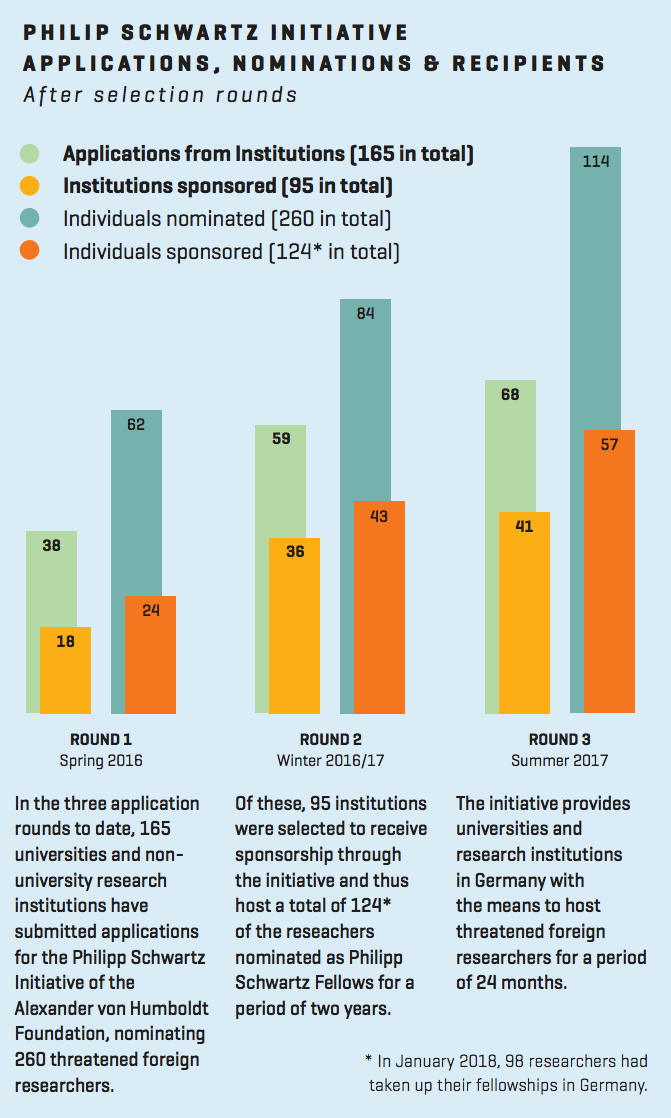 The top three countries IIE-SRF has received applications from are Iraq, Syria and Turkey. Last year they accounted for around two-thirds of the 200 scholars supported by IIE-SRF. In recent months, IIE-SRF has also seen a jump in the number of Yemeni applicants – a 25% increase between all of 2017 and the first five months of 2018. Scholars at Risk reported the top five risks such researchers face: Risk of arrest or imprisonment; insecurity or conflict; wrongful dismissal; harassment and intimidation; or fear of being killed or kidnapped.
The top three countries IIE-SRF has received applications from are Iraq, Syria and Turkey. Last year they accounted for around two-thirds of the 200 scholars supported by IIE-SRF. In recent months, IIE-SRF has also seen a jump in the number of Yemeni applicants – a 25% increase between all of 2017 and the first five months of 2018. Scholars at Risk reported the top five risks such researchers face: Risk of arrest or imprisonment; insecurity or conflict; wrongful dismissal; harassment and intimidation; or fear of being killed or kidnapped.
Stephen Wordsworth, executive director of CARA, said his organisation has a sense of where scientists’ situations are most dire. And in recent years, their level of inquiries about placements is at its peak, mostly because of applications from Syria, due to the civil war, and Turkey, due to political conflict there. “Say two or three years ago, we were getting four or five inquiries a week,” he said. “Come late summer 2016, it was about 20 a week. Now it has come down again to about 10, but that’s still high by historical levels.”
Shreya Balhara, the program associate for protection services of Scholars at Risk, said her organization saw a similar trend, and at the moment, Turkish scholars now make up the largest portion of their applications since July 2016, growing from 23 before 2016 to a cumulative total of 831 as of June 2018.
Iraqi, too, has endured a significant loss of professionals in the science sector, dating back to the U.S. invasion in 2003. Soon after IIE-SRF was founded in 2002, it undertook urgent work with support from the U.S. State Department and private foundations to rescue Iraqi scholars threatened by the Iraq War that began in 2003 and in the ensuing sectarian violence.
The Guardian estimated in 2017 that 450 academics had been killed since 2003. Many scholars returned home to Iraq during the calmer period from 2007 to 2014. But the escalating attacks of Islamic State in 2014 created a whole new refugee crisis, and academics began contacting support agencies all over again. Scholars at Risk counted 35 reported attacks on Iraq university professionals from May 2015 to September 2016.
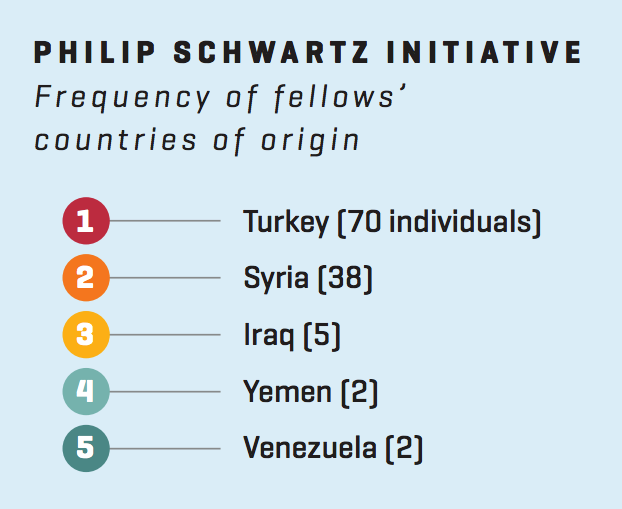 As the conflict with Islamic State raged in Iraq, the impact was deep – and measurable. Research physicist Ahmed Al-Tabbakh, a TWAS Young Affiliate at Al-Nahrain University in Baghdad, reports that number of faculty members at Iraqi universities dropped by more than 5,000 – from 40,993 to 35,362 – between the spring term and the fall term in 2014. Nobody tracked where they had gone, Al-Tabbakh said.
As the conflict with Islamic State raged in Iraq, the impact was deep – and measurable. Research physicist Ahmed Al-Tabbakh, a TWAS Young Affiliate at Al-Nahrain University in Baghdad, reports that number of faculty members at Iraqi universities dropped by more than 5,000 – from 40,993 to 35,362 – between the spring term and the fall term in 2014. Nobody tracked where they had gone, Al-Tabbakh said.
Now, with Islamic State largely defeated, faculty are starting to return home. But some are finding the research infrastructure damaged or destroyed. The University of Mosul, for example, suffered extensive damage.
“A fairly high percentage of Iraqi professors have returned back. Are they returning to a good situation? Not necessarily,” King said. “A more hopeful situation than three years ago? Absolutely. The challenge for us is to determine ways to find ways to support Iraqi higher education as Iraq transitions back into a better functioning state.”
The challenges ahead
The haziness of the available numbers illustrates an important reality: when it comes to understanding the full scope of the problem, more support and funding for research is essential. That effort is needed today, for countries such as Syria, Afghanistan, Iraq and Yemen, and also for countries such as Venezuela, where thousands of professionals are reportedly leaving the country. Almost inevitably, the future will bring other conflicts that drive science-related communities into exile.
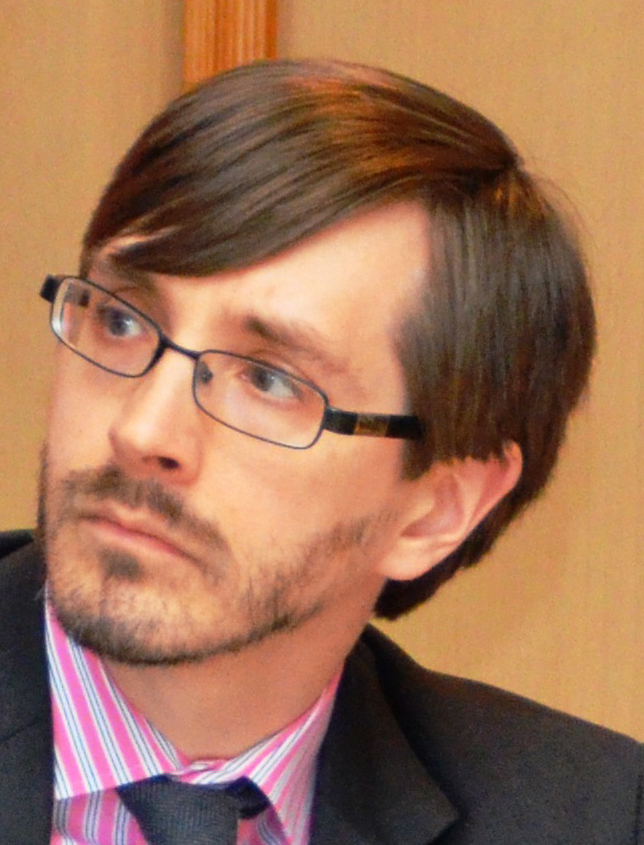 A comprehensive set of recommendations issued in May 2017 from a high-level meeting of experts co-organised by TWAS argues that science organisations, universities and policymakers should undertake broad efforts to identify research professionals among war refugees. It calls for accessible new refugee databases that track scientists and their educational level, fields of expertise and movements. It urges policymakers that this effort is important because precisely tracking displaced researchers will help assure that they can get back to work in their new countries.
A comprehensive set of recommendations issued in May 2017 from a high-level meeting of experts co-organised by TWAS argues that science organisations, universities and policymakers should undertake broad efforts to identify research professionals among war refugees. It calls for accessible new refugee databases that track scientists and their educational level, fields of expertise and movements. It urges policymakers that this effort is important because precisely tracking displaced researchers will help assure that they can get back to work in their new countries.
“Such affected scientists with scientific, medical or other professional training can be a valuable resource if identified and provided with support for integration into the research/academic environment in their new countries,” says the recommendation. “They are able to contribute to society, including research output, in the country where they reside. They typically also retain links with their home countries, becoming connected with likeminded individuals in a diaspora.”
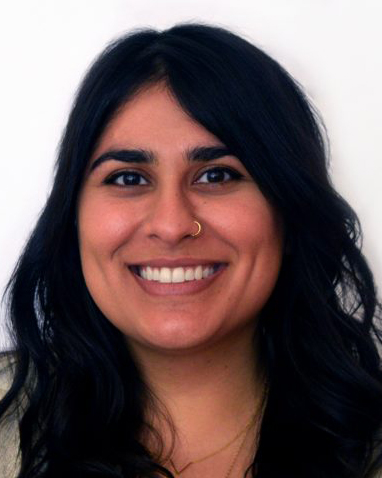 The challenge is no small task. The reason the numbers are not precise is that organizations like IIE-SRF, CARA and Scholars At Risk exist to find and help the scientists they have funding for, not to build a database that can estimate the size of the problem, said David Wheeler, editor, Al Fanar Media, a news outlet that regularly covers the plights of displaced researchers.
The challenge is no small task. The reason the numbers are not precise is that organizations like IIE-SRF, CARA and Scholars At Risk exist to find and help the scientists they have funding for, not to build a database that can estimate the size of the problem, said David Wheeler, editor, Al Fanar Media, a news outlet that regularly covers the plights of displaced researchers.
“Nobody really has the money to estimate the size of the problem or put together any kind of clear database,” said Wheeler.
Refugees endure chaos, uncertainty, and major decisions under intense life-or-death pressure. So documentation proving the status as researchers often gets left behind, making data collection on their status as researchers difficult.
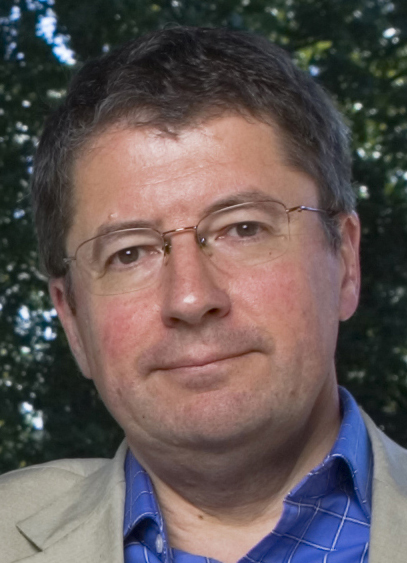 “You have to look at the heart of what the refugee experience is,” Wheeler said. “If a mortar shell drops on your home in the middle of the night, you don’t think about whether you have your bachelor’s degree or PhD certification. You just get out of there fast, if you can, with your family. Likewise, if government security comes to your house, and your family tells you they were looking for you, you don’t worry about whether you have your laptop with you. You run.”
“You have to look at the heart of what the refugee experience is,” Wheeler said. “If a mortar shell drops on your home in the middle of the night, you don’t think about whether you have your bachelor’s degree or PhD certification. You just get out of there fast, if you can, with your family. Likewise, if government security comes to your house, and your family tells you they were looking for you, you don’t worry about whether you have your laptop with you. You run.”
This also makes placement hard, because students need transcripts and faculty members need PhD certification to get a job at a university. So the organizations and scientists both urge the universities or ministries to make special exceptions, leading to lengthy delays. Displaced researchers also lose their professional contacts’ emails and phone numbers. And for students, transcripts serve as educational passports and they need to be able to store and maintain those records securely.
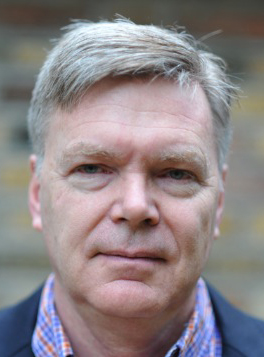 There are options, including the potential of a cloud-based online system for storing displaced academics’ essential documents which could help not just the students but numerical record-keeping efforts in general.
There are options, including the potential of a cloud-based online system for storing displaced academics’ essential documents which could help not just the students but numerical record-keeping efforts in general.
Finally, the organizations also don’t actively seek out scholars to rescue. They rely completely on numbers in their application pool – made up of researchers who seek them out. Researchers who don’t go through this application process go mostly unnoticed, and an overall database would help these agencies identify those displaced scientists who fall through the cracks.
“We only know the numbers of those who apply,” said Balhara. “Some countries are quite restrictive about internet access, so some people might feel fearful about connecting with an outside entity or just aren’t able to access that information online.”
Science diplomacy can be a critically important tool in building international cooperation to address these issues.
Governments, international organizations, civil society, businesses and universities are all well-positioned to collaborate to aid refugee scientists, said Canadian Daryl Copeland, an author and veteran diplomat who participated the Trieste workshop that drafted the recommendations.
“But they face a knowledge and information gap,” Copeland said. “The problem of how best to harness the untapped potential resource of diaspora and refugee scientists … falls squarely within the province of science diplomacy.”
Sean Treacy

